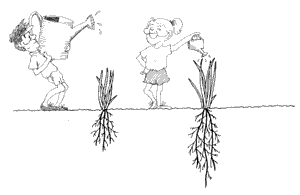Good Soil Means Less Watering
Different Soils Means Different Watering

Organic Material Stores Water
The key to effective watering of lawns and all landscape plantings is the quality of the soil they are growing in. Compacted soil--where the air has been compressed out of it from builders’ equipment and years of foot traffic--is the norm in most residential landscapes in this country. It is least able to absorb and hold moisture from rainfall that plants need. So the first step in responsible watering is to improve your soil so that it can store rain water and hold it available for plants.
To correct soil compaction, aerate your lawn. To make it water absorbent topdress it with some organic material such as chopped leaves, peat moss or topsoil to build up its organic content to 3 to 5% of the soil. Organic material feeds billions of microbes that condition and enrich the soil. It also stores water. Particles of organic matter act like microscopic sponges, so enriched soil holds more moisture longer after a rain--two to three times longer--than typical, compressed, thin soil. The more able the soil is to store water, the longer the grass can go without rain or watering
Deep Roots Need Less Water

Grass plants growing in compacted soil have shallow root systems because they can not penetrate the soil. They always need more watering than grass with deep root systems. Deep roots are able to find moisture down in the soil and use it so efficiently that they can withstand long dry periods. The roots of healthy turfgrass can grow at least 4 to 6 inches deep. Kentucky bluegrass is capable of generating root systems as long as 8 inches and turftype tall fescue can produce 12 inch long roots if the soil is healthy--if it is aerated and contains organic material.
Inspect the roots of your grass by digging up a plug or splitting the turf apart with a spade. If the grass roots penetrate only about 2 inches into the soil, your grass is extremely vulnerable to drought and will always need extra watering.
Proper Lawn Care Means Less Watering
How you care for your grass makes a big difference in how much additional water it needs to remain green. Certain techniques encourage deeper grass roots and, therefore, reduce water needs.
Mow Tall - Tall grass, 2 inches or higher, grows deeper roots. More foliage surface increases its ability to take energy from the sun and grow vigorously. The longer blades also shade the soil, reducing normal evaporation of moisture. Leaving the clippings as you mow creates a light mulch around the base of the grass plants that also reduces the loss of soil moisture water through evaporation.
Use A Sharp Blade - A sharp mower blade cuts grass foliage cleanly. By avoiding ragged blade tips, which release more moisture from the plant into the atmosphere, you conserve more moisture for use by the plant.
Fertilize Lightly - Excessive nitrogen stimulates rapid blade growth above the mowing level and into air currents which "wick away" moisture from the tissues of the blades, again reducing moisture available to the grass plants. Overdoses of nitrogen require more frequent mowing, which, in turn, limits the development of deep root systems. Limit any single application of nitrogen to less than 1 pound per 1000 square feet. Constantly regrowing blades in response to mowing uses more water. During drought periods underdeveloped roots can not keep up with this demand for water and stressed, wilting grass frequently signals that it needs watering.
Good Timing Saves Water
Avoid Spring Irrigation--Do not water your lawn at all in the spring. This will prevent the grass from becoming overly dependent on a steady water supply. Slight drying out of the soil in the spring stimulates grass roots to reach deeper into the soil for moisture. This will pay off for the grass plants later, when the going gets tough in the summer heat.
Avoid Major Maintenance Activities in Summer--Applying fertilizers and pesticides, aerating, and dethatching put extra stress on grass plants so they need more water. Do these tasks in the spring and the fall. It's easier on the yardener as well as on the grass then.
